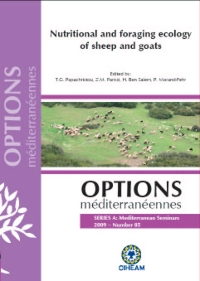| Article précédent | p. 315-322 | Article suivant |
Goat kid's growth improvement with a lactic probiotic fed on a standard base diet
The objective of the present study was to increase kid's growth fed on alfalfa hay (Medicago sativa) and a high protein concentrate, with the addition of a lactic probiotic containing lactobacilli. A 120 day experiment was carried out in Mexico with 80 alpine kids divided in two groups, with two goats fixed with ruminal cannulas in each group. The basal diet was made of 55% alfalfa and 45% high protein concentrate. Kids in treatment 1 (T1) were fed on a basal diet only. Animals in treatment 2 (T2) were fed on a basal diet mixed with a lactic probiotic solution. Daily weight gain were 129 g/d and 169 g/d for T1 and T2 respectively (P < 0.05). NH3 concentration was higher in T2 (P < 0.05). Nitrogen digestibility was greater in T2 (80.2%) in comparison with T1 (57.6%). Fibre digestibility was better in T2 (P < 0.05). NDF digestibility were improved in T2 (P < 0.05). True digestibility was 47.7% in T2 and 38.3% in T1. Half-time disappearance for hemicellulose was higher (P < 0.05) for T2 (32.03 h) compared to T1 (17.37 h). Lactobacillus plantarum, L. helvaticus, L. delbrueckii, Lactoccocus lactis, L. cremoris and Leuconostoc mesenteroides were identified. Lactobacilli counts were 1.6 and 4.4 million/ml the first day and increased to 5.5 and 12.5 million/ml in 7 days. Purines were significantly increased with the probiotic diet of T2 (P < 0.05). Adding a probiotic to the diet increased body weight gain and digestibility of fibre in the rumen of goat kids in T2.
L'objectif de la présente étude était d'améliorer la valeur nutritive d'un régime basé sur le foin de luzerne (Medicago sativa) et un concentré riche en protéines par l'adjonction de probiotique lactique. Une expérience de 120 jours a été réalisée au Mexique avec 80 chevreaux divisés en deux groupes avec deux chevreaux de chaque groupe munis de canules ruminales. Les chevreaux dans le traitement 1 (T1) ont reçu la ration de base sans supplémentation. Les animaux dans le traitement 2 (T2) ont été alimentés par la même ration de base mais enrichie de probiotique. Le gain de poids quotidien était, respectivement, de 129 g/j et 169 g/j pour T1 et T2 (P < 0,05). La concentration de NH3 était plus élevée avec T2 (P < 0,05). La digestibilité de l'azote était plus élevée avec T2 (80,2%) en comparaison avec T1 (57,6%). La digestibilité de la paroi totale était aussi plus élevée avec T2 (P < 0,05). La digestibilité réelle était de 47,7% avec T2 et 38,0% avec T1. La disparition d'hémicellulose dans le rumen était plus importante (P < 0,05) avec T2 (32,03 h) par comparaison à T1 (17,37 h). Lactobacillus plantarum, L. helvaticus, L. delbrueckii, Lactoccocus lactis cremoris et Leuconostoc mesenteroides ont été identifiés. Le nombre de lactobacilli a varié de 1,6 à 4,4 millions/ml au premier jour et a augmenté à 5,5 et 12,5 millions/ml en 7 jours. Les concentrations des dérivés des bases puriques ont nettement augmenté avec l'apport du probiotique (P < 0,05). En conclusion, il ressort que l'adjonction d'un probiotique permet d'augmenter la digestibilité des fibres dans le rumen et d'améliorer la croissance des chevreaux.
- [ Afficher ]
- [ Télécharger ]
- [ Exporter la citation ]
Vous pouvez télécharger la citation au format :
- [ Imprimer ]
-
Mots-clés
CHEVREAU, CROISSANCE, DIGESTIBILITE, LUZERNE, PROBIOTIQUE, RATION, REGIME ALIMENTAIRECiter cet article
Galina M.A., Ortiz-Rubio M.A., Delgado-Pertiñez M., Pineda L.J. Goat kid's growth improvement with a lactic probiotic fed on a standard base diet. In : Papachristou T.G. (ed.), Parissi Z.M. (ed.), Ben Salem H. (ed.), Morand-Fehr P. (ed.). Nutritional and foraging ecology of sheep and goats. Zaragoza : CIHEAM / FAO / NAGREF, 2009. p. 315-322. (Options Méditerranéennes : Série A. Séminaires Méditerranéens; n. 85). 12. Seminar on: Nutritional and Foraging Ecology of Sheep and Goats, 2007/10/11-13, Thessaloniki (Greece). http://om.ciheam.org/om/pdf/a85/00801024.pdf



